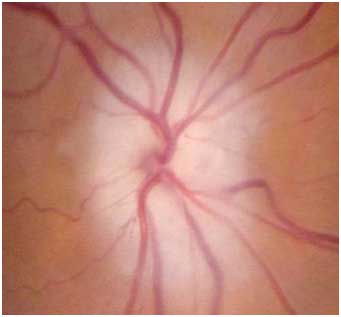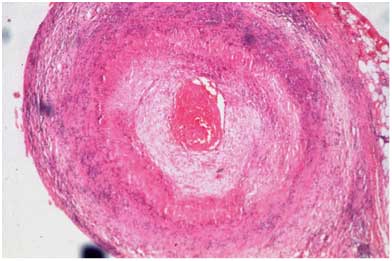Arteritic Anterior Ischemic Optic Neuropathy (AAION) – Also known as Temporal arteritis or Giant cell arteritis
In arteritic anterior ischemic optic neuropathy (AAION), inflammation in small arteries, including those that supply the optic nerve, blocks the blood vessels eventually stopping blood flow to the optic nerve.
This process can initially cause transient vision loss in one eye, but can rapidly progress to severe, permanent vision loss and then involve the second eye if left untreated.
Many patients also present with headaches, scalp tenderness, jaw pain while chewing, new muscle aches, weight loss, and fevers.
Figure 1. Optic disc swelling and paleness in the affected eye in a patient with AAION.
Figure 2. Temporal artery biopsy in a patient with giant cell arteritis showing inflammation of the blood vessel walls leading to narrowing of the blood vessel.
When temporal arteritis is suspected, a complete eye examination, visual field testing, and special pictures of the optic nerve will be performed. In addition, blood tests looking for the elevation of the erythrocyte sedimentation rate (ESR) will be obtained.
If the ESR is elevated, a temporal artery biopsy will be performed to confirm the diagnosis.
The biopsy is a simple procedure to remove a small sample of the temporal artery that is then sent to a pathologist to look for specific inflammatory cells called “giant cells.”
The biopsy can usually be performed in the office, but may sometimes need to be done in the operating room.
In both highly suspected cases where the biopsy cannot be immediately obtained and confirmed cases of temporal arteritis, steroids will be started immediately. The steroid reduces the inflammation and allows for the blood flow to return to the eyes.
In most cases, the vision loss is permanent, but the steroids will help prevent further vision loss or involvement of the second eye.
Patients will need to be on steroids for several months to over a year and will be treated by a rheumatologist during this time. Due to the side effects of steroids, patients will also need to be monitored closely by their primary care provider.
For additional information: view PDF brochure from the North American Neuro-Ophthalmology Society (NANOS).


